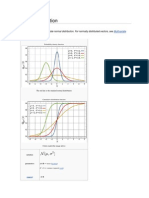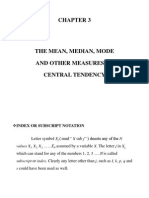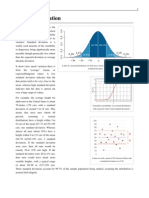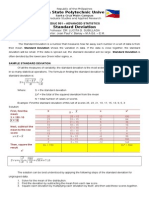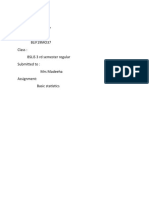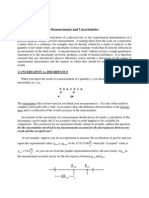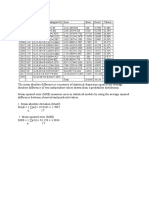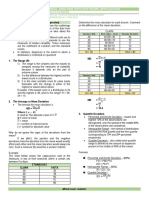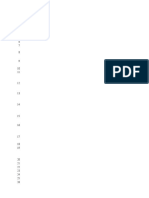Standar Deviasi
Standar Deviasi
Uploaded by
Åwink BeêCopyright:
Available Formats
Standar Deviasi
Standar Deviasi
Uploaded by
Åwink BeêCopyright
Available Formats
Share this document
Did you find this document useful?
Is this content inappropriate?
Copyright:
Available Formats
Standar Deviasi
Standar Deviasi
Uploaded by
Åwink BeêCopyright:
Available Formats
The Standard Deviation and other Measures of Dispersion
DISPERSION OR VARIATION The degree to which numerical data tend to spread about an average value is called the variation or dispersion of the data. Various measures of dispersion or variation are available, the most common being the range, mean deviation, semiinterquartile range, 10-90 percentile range, and the standard deviation. THE RANGE The range of a set of numbers is the difference between the largest and smallest numbers in the set. Example: The range of the set 2, 3, 3, 5, 5, 5, 8, 10, 12 is 12 2 = 10. Sometimes the range is given by simply quoting the smallest and largest numbers. In the above example, for instance, the range could be indicated as 2 to 12 or 2-12.
THE MEAN DEVIATION, OR AVERAGE DEVIATION, of a set of N numbers X1, X2, . XN is defined by Mean Deviation = M.D. where X is the arithmetic mean of the numbers and |Xj is the absolute value of the deviation of Xi from Y. (The absolute value of a number is the number without the associated sign and is indicated by two vertical lines placed around the number. Thus |-41 = 4,1+31 = 3, 61 = 6, 1-0.841 = 0-84.) Example: Find the mean deviation of the set of numbers 2, 3, 6, 8, 11
Arithmetic Mean = Mean Deviation = M.D.
If X1, X2, . . XK occur with frequenciesf,,f2, . . fK res pectively, the mean deviation can be written as Mean Deviation = M.D.
Where N =
This form is useful for grouped
data where the XD's represent class marks and the fj's are the corresponding frequencies. Occasionally the mean deviation is defined in terms of absolute deviations from the median or other average instead of the mean. An interesting property of the sum al is that it is a minimum when a is the median, i.e. the mean deviation about the median is a minimum. Note that it would be more appropriate to use the terminology, mean absolute deviation rather than mean deviation. THE SEMI-INTERQUARTILE RANGE OR QUARTILE DEVIATION of a set of data is defined by
Semi-interquartile Range = Q = where Q1 and Q, are the first and third quartiles for the data. See Problems 4.6 and 4.7. The interquartile range Q3 Q, is sometimes used but the semi-interquartile range is more common as a measure of dispersion. THE 10-90 PERCENTILE RANGE of a set of data is defined by 10-90 Percentile Range = P90 P10 (4) where P10 and P90 are the 10th and 90th percentiles for the data (see Prob. 4.8). The semi-10-90 percentile range, +(P90 - P10), can also be used but is not commonly employed. THE STANDARD DEVIATION of a set of N numbers X,, X2, . . XN is denoted by s and is defined by
s=
where x represents the deviations of each of the numbers XJ from the mean X. Thus s is the root mean square of the deviations from the mean or, as it is sometimes called, the root mean square deviation (see Page 49). If X1, X2, ..., Xj, occur with frequencies.f1,f2,...,fK respectively, the standard deviation can be written as
s=
where N =
f. In this form it is useful
for grouped data. Sometimes the standard deviation for the data of a sample is defined with (N-1) replacing N in the denominators of the expressions in (5) and (6) because the resulting value represents a better estimate of the standard deviation of a population from which the sample is taken. For large values of N (certainly N > 30) there is practically no difference between the two definitions. Also, when the better estimate is needed we can always obtain it by multiplying the standard deviation computed according to the first definition by
Hence we shall adhere to the definition given
above.
THE VARIANCE The variance of a set of data is defined as the square of the standard deviation and is thus given by s2 in (5) and (6). When it is necessary to distinguish the standard deviation of a population from the standard deviation of a sample drawn from this population, we often use the symbol s for the latter and a for the former. Thus s2 and n2 would represent the sam SHORT METHODS FOR COMPUTING THE STANDARD DEVIATION The equations (5) and (6) can be written respectively in the equivalent forms
s= s=
where denotes the mean of the squares of the various values of X, while X2 denotes the square of the mean of the various values of X. See Problems 4.12 to 4.14. If d = Xi - A are the deviations of X from some arbitrary constant A, the results (7) and (8) become respectively
s=
s=
See Problems 4.15 and 4.17. When data are grouped into a frequency distribution whose class intervals have equal size c, we have = cuj or Xi = A + cuj and (10) becomes s=
This last formula provides a very short method for computing the standard deviation and should always be used for grouped data when class interval sizes are equal. It is called the coding method and is exactly analogous to that used in computing the arithmetic mean for grouped data in Chapter 3. See Problems 4.16 to 4.19. PROPERTIES OF THE STANDARD DEVIATION 1. The standard deviation can be defined as s = where a is an average besides the arithmetic mean. Of all such standard deviations, the minimum is that for which a = X, because of Property (b), Chap. 3, Page 46. This property provides an important reason for defining the standard deviation as above. For a proof of this property see Prob. 4.27.
2. For normal distributions (see Chapter 7) it turns out that : 68,27% of the cases are included between s and D +S (i.e. one standard deviation on either side of the mean) b. 95.45% of the cases are included between 2s and + 2s (i.e. two standard deviations on either side of the mean) c. 9973 Y. of the cases are included between 3s and + 3s (i.e. three standard deviations on either side of the mean) a. as indicated in Fig. 4-1. For moderately skewed percentages Prob. 4.24).
distributions
the
above
3.
Suppose that two sets consisting of N1 and N2 numbers (or two frequency distributions with total frequencies N, and N2) have variances given by 4 and s2 respectively and the same mean X. Then the combined or pooled variance of both sets (or both frequency distributions) is given by
Note that this is a weighted arithmetic mean of the variances. This result can be generalized to 3 or more sets.
CHARLIER'S CHECK Charlier's check in computations of the mean and standard deviation by the coding method makes use of the identities
See Problem 4.20. SHEPPARD'S CORRECTION FOR VARIANCE
SHEPPARD'S CORRECTION FOR VARIANCE The computation of the standard deviation is somewhat in error due to grouping of data into classes (grouping error). To adjust for grouping error we use the result. Corrected Variance = Variance from grouped data c2/12 where c is the class interval size. The correction c2/12 which is subtracted is called Sheppard's correction. It is used for distributions of continuous variables where the "tails" go gradually to zero in both directions. Statisticians differ as to when and whether Sheppard's corrections should be applied. Certainly they should not be applied without thorough examination of the situation. This is so because often they tend to overcorrect and thus replace old errors by new errors. In this book unless otherwise indicated we shall not use these corrections.
EMPIRICAL RELATIONS BETWEEN MEASURES OF DISPERSION For moderately skewed distributions we have the empirical formulae Mean Deviation Semi-interquartile Range (Standard Deviation) (Standard Deviation)
These are consequences of the fact that for the normal distribution we find that the mean deviation and semiinterquartile range are equal respectively to 0.7979 and 0-6745 times the standard deviation.
ABSOLUTE AND RELATIVE DISPERSION. COEFFICIENT OF VARIATION
The actual variation or dispersion as determined from the standard deviation or other measure of dispersion is called the absolute dispersion. However, a variation or dispersion of 1 metre in measuring a distance of 1000 metres is quite different in effect from the same variation of 1 metre in a distance of 20 metres. A measure of this effect is supplied by the relative dispersion defined by
If the absolute dispersion is the standard deviation s and the average is the mean X, the relative dispersion is called the coefficient of variation or coefficient of dispersion given by Coefficient of Variation = V =
and is generally expressed as a percentage. Other possibilities also occur (see Problem 4.30). Note that the coefficient of variation is independent of units used. For this reason it is useful in comparing distributions where units may be different. A disadvantage of the coefficient of variation is that it fails to be useful when X is close to zero.
STANDARDIZED VARIABLE, STANDARD SCORES The variable z = which measures the deviation from the mean in units of the standard deviation is called a standardized variable and is a dimensionless quantity (i.e. is independent of units used). If deviations from the mean are given in units of the standard deviation, they are said to be expressed in standard units or standard scores. These are of great value in comparison of distributions (see Problem 4.31).
You might also like
- Cu p2 Statistical Analysis Om PatelDocument7 pagesCu p2 Statistical Analysis Om PatelomNo ratings yet
- New Microsoft Office Word DocumentDocument941 pagesNew Microsoft Office Word DocumentPriya VenugopalNo ratings yet
- A Quick Approach To Statistics by G.R.pashADocument210 pagesA Quick Approach To Statistics by G.R.pashAAshfaq Khan75% (12)
- Medical Statistics and Demography Made Easy®Document353 pagesMedical Statistics and Demography Made Easy®Dareen Seleem100% (1)
- Biostatistics For Academic2Document38 pagesBiostatistics For Academic2Semo gh28No ratings yet
- Virtual University of Pakistan: Lecture No. 11Document39 pagesVirtual University of Pakistan: Lecture No. 11Atif KhanNo ratings yet
- Descriptive Statistics For Hicm UndergraduateDocument18 pagesDescriptive Statistics For Hicm UndergraduateThelma FortuNo ratings yet
- Measures of VariabilityADocument19 pagesMeasures of VariabilityAcaileyandrea19No ratings yet
- Measures of DispersionDocument32 pagesMeasures of DispersionShahmeerNo ratings yet
- Measures of DispersionDocument13 pagesMeasures of Dispersionsabnira AfrinNo ratings yet
- Dispersion 1Document32 pagesDispersion 1Karishma ChaudharyNo ratings yet
- Variance and Standard DeviationDocument4 pagesVariance and Standard Deviationapi-150547803No ratings yet
- Standard Deviation - Wikipedia, The Free EncyclopediaDocument12 pagesStandard Deviation - Wikipedia, The Free EncyclopediaManoj BorahNo ratings yet
- ShapesDocument36 pagesShapesaue.ponytoyNo ratings yet
- 2.2 Unit-DspDocument63 pages2.2 Unit-Dspsuryashiva422No ratings yet
- Stats and Prob Reviewer, Q3 Jess Anch.Document8 pagesStats and Prob Reviewer, Q3 Jess Anch.JessicaNo ratings yet
- Mohan MathsDocument16 pagesMohan Mathsmohan75xNo ratings yet
- الفصل الثاني الاحصاءDocument27 pagesالفصل الثاني الاحصاءbifusk481No ratings yet
- Chapter 5 Measures of DispersionDocument31 pagesChapter 5 Measures of Dispersionhanageenyo99No ratings yet
- IntroBioInfStatistics - Chapter2.revised 8956517989503105Document28 pagesIntroBioInfStatistics - Chapter2.revised 8956517989503105Edn Ed EddieNo ratings yet
- Chapter 4Document48 pagesChapter 4alex tomsonNo ratings yet
- Chapter 4 Measures of DispersionDocument45 pagesChapter 4 Measures of Dispersionmonicabalamurugan27No ratings yet
- 23006026_NUR HAMNI_TASK 7 STAT. DESKRIPTIF englishDocument10 pages23006026_NUR HAMNI_TASK 7 STAT. DESKRIPTIF englishnurhamni35No ratings yet
- Chapter-3ni Kamote ChuaDocument29 pagesChapter-3ni Kamote ChuaBryan GonzalesNo ratings yet
- Mathematics Statistical Square Root Mean SquaresDocument5 pagesMathematics Statistical Square Root Mean SquaresLaura TaritaNo ratings yet
- Last Formuas of First ChapterDocument20 pagesLast Formuas of First ChapterBharghav RoyNo ratings yet
- Measures of Variability GROUPED DATADocument13 pagesMeasures of Variability GROUPED DATAtojiflms100% (1)
- Mean, MedianDocument26 pagesMean, MedianAliNurRahmanNo ratings yet
- Standard Deviation-From WikipediaDocument11 pagesStandard Deviation-From WikipediaahmadNo ratings yet
- MAT2001-Statistics For Engineers: Measures of VariationDocument22 pagesMAT2001-Statistics For Engineers: Measures of VariationBharghav RoyNo ratings yet
- Measures of DispersionDocument3 pagesMeasures of DispersionAbrar AhmadNo ratings yet
- StatestsDocument20 pagesStatestskebakaone marumoNo ratings yet
- Measures of Dispersion TendencyDocument7 pagesMeasures of Dispersion Tendencyashraf helmyNo ratings yet
- Standerd DiviationDocument14 pagesStanderd DiviationPrageeth Nalaka ArambegedaraNo ratings yet
- Chapter 4Document46 pagesChapter 4Javeria NaseemNo ratings yet
- Laguna State Polytechnic University: Professor: Dr. Lucita G. Subillaga Reporter: Jean Paul V. Banay - M.A.Ed. - E.MDocument4 pagesLaguna State Polytechnic University: Professor: Dr. Lucita G. Subillaga Reporter: Jean Paul V. Banay - M.A.Ed. - E.MRyan Paul NaybaNo ratings yet
- Measure VariabilityDocument6 pagesMeasure VariabilityAlexander DacumosNo ratings yet
- Chapter 4-1Document46 pagesChapter 4-1Shahzaib SalmanNo ratings yet
- Chapter 4Document8 pagesChapter 4NJeric Ligeralde AresNo ratings yet
- Haseeb Akbar 37 Statistics AssignmentDocument45 pagesHaseeb Akbar 37 Statistics AssignmentHaseeb AkbarNo ratings yet
- Theory of Uncertainty of Measurement PDFDocument14 pagesTheory of Uncertainty of Measurement PDFLong Nguyễn VănNo ratings yet
- Absolute Measure of DispersionDocument4 pagesAbsolute Measure of DispersionMuhammad ImdadullahNo ratings yet
- Univariate StatisticsDocument4 pagesUnivariate StatisticsDebmalya DuttaNo ratings yet
- The Scalar Algebra of Means, Covariances, and CorrelationsDocument21 pagesThe Scalar Algebra of Means, Covariances, and CorrelationsOmid ApNo ratings yet
- Measures of Dispersion - Range, Deviation and Variance With ExamplesDocument14 pagesMeasures of Dispersion - Range, Deviation and Variance With ExamplesDCNo ratings yet
- Dispersion: Handout #7Document6 pagesDispersion: Handout #7Bonaventure NzeyimanaNo ratings yet
- Measure of dispersionDocument2 pagesMeasure of dispersionariffuad38No ratings yet
- Chapter 5_Measures of VariabilityDocument35 pagesChapter 5_Measures of VariabilityANo ratings yet
- 3median - WikipediaDocument44 pages3median - WikipediajlesalvadorNo ratings yet
- Variance and Standard DeviationDocument15 pagesVariance and Standard DeviationSrikirupa V Muraly100% (3)
- Measures of Dispersion - 1Document44 pagesMeasures of Dispersion - 1muhardi jayaNo ratings yet
- Chap2 Numerical Summary Measures UploadDocument54 pagesChap2 Numerical Summary Measures Uploadbảo thếNo ratings yet
- Summary Statistics, Distributions of Sums and Means: Joe FelsensteinDocument21 pagesSummary Statistics, Distributions of Sums and Means: Joe FelsensteinmhdstatNo ratings yet
- technical-analysis-PDFdrive-10Document17 pagestechnical-analysis-PDFdrive-1020mayis20No ratings yet
- Class Notes v1Document4 pagesClass Notes v1Parvat ChavhanNo ratings yet
- Statistic and ProbabilityDocument15 pagesStatistic and ProbabilityFerly TaburadaNo ratings yet
- BBBDocument9 pagesBBBchxrlslxrrenNo ratings yet
- MCT Biost FuoDocument10 pagesMCT Biost Fuofelixebikonbowei2022No ratings yet
- (213805375) DispersionDocument49 pages(213805375) DispersionshahjafferNo ratings yet
- Measures of VariationDocument30 pagesMeasures of VariationJahbie ReyesNo ratings yet
- Student's Solutions Manual and Supplementary Materials for Econometric Analysis of Cross Section and Panel Data, second editionFrom EverandStudent's Solutions Manual and Supplementary Materials for Econometric Analysis of Cross Section and Panel Data, second editionNo ratings yet
- Measures of VariabilityDocument21 pagesMeasures of VariabilitybeckonashiNo ratings yet
- 11 Stat 6 Measures of DispersionDocument17 pages11 Stat 6 Measures of Dispersioneco protectionNo ratings yet
- Chapter 4&5Document33 pagesChapter 4&5Geez DesignNo ratings yet
- Decision ScienceDocument9 pagesDecision ScienceSourav SaraswatNo ratings yet
- Lesson 10 Measures of Variability - Grouped Data High SchoolDocument13 pagesLesson 10 Measures of Variability - Grouped Data High SchoolAlbec Sagrado Ballacar100% (1)
- Detailed Lesson Plan in Mathematics 8Document7 pagesDetailed Lesson Plan in Mathematics 8Leon MathewNo ratings yet
- Operations Management Chapter 3Document37 pagesOperations Management Chapter 3Tina Dulla67% (3)
- Mean Median Mode PDFDocument52 pagesMean Median Mode PDFSunpreet Kaur NandaNo ratings yet
- 405d - Business StatisticsDocument21 pages405d - Business StatisticsSaurabh AdakNo ratings yet
- Mean Deviation Problems PDFDocument10 pagesMean Deviation Problems PDFRaghavendra JeevaNo ratings yet
- Lecture No 9Document24 pagesLecture No 9Wra ArirmiwniNo ratings yet
- NCERT Solutions For Class 11 Maths Chapter - 15 StatisticsDocument6 pagesNCERT Solutions For Class 11 Maths Chapter - 15 StatisticsMukund YadavNo ratings yet
- Measure of Dispersion (Range Quartile & Mean Deviation)Document55 pagesMeasure of Dispersion (Range Quartile & Mean Deviation)Wasie UrrahmanNo ratings yet
- Maths 2A SeniorDocument14 pagesMaths 2A SeniorARAVIND ARV7733% (3)
- Measures of Dispersion (Unit1)Document36 pagesMeasures of Dispersion (Unit1)Rishab Jain 2027203100% (1)
- Exemplar Distance Learning LessonDocument4 pagesExemplar Distance Learning Lessonapi-636150180No ratings yet
- Qtns On MGTDocument28 pagesQtns On MGTSamuela Baby-Naa AttuquayefioNo ratings yet
- Central Tendency and VariabilityDocument20 pagesCentral Tendency and VariabilityAli AkbarNo ratings yet
- GE 7 Module 4Document33 pagesGE 7 Module 4Emmanuel DalioanNo ratings yet
- Lecture 6 - Measures of VariabilityDocument3 pagesLecture 6 - Measures of VariabilityRae WorksNo ratings yet
- Topic: Measures of Dispersion (Test 1) : Type Questions Get Answers MCQ Quiz Online English Objective Test MCQ TestDocument2 pagesTopic: Measures of Dispersion (Test 1) : Type Questions Get Answers MCQ Quiz Online English Objective Test MCQ Testzaheer abbasNo ratings yet
- CHAPTER5 Assessment AnswerDocument20 pagesCHAPTER5 Assessment AnswerJulius BalbinNo ratings yet
- Chapter - 4 DispersionDocument10 pagesChapter - 4 DispersionKishan GuptaNo ratings yet
- Chapter-11 Measures of Dispersion: Class XIDocument30 pagesChapter-11 Measures of Dispersion: Class XIcheshaNo ratings yet
- NMDocument18 pagesNMAmrinderpal SinghNo ratings yet
- Average DeviationDocument2 pagesAverage DeviationRandom Bll ShTNo ratings yet
- UNIT IV Dispersion and SkewnessDocument12 pagesUNIT IV Dispersion and SkewnessVidhya BNo ratings yet

